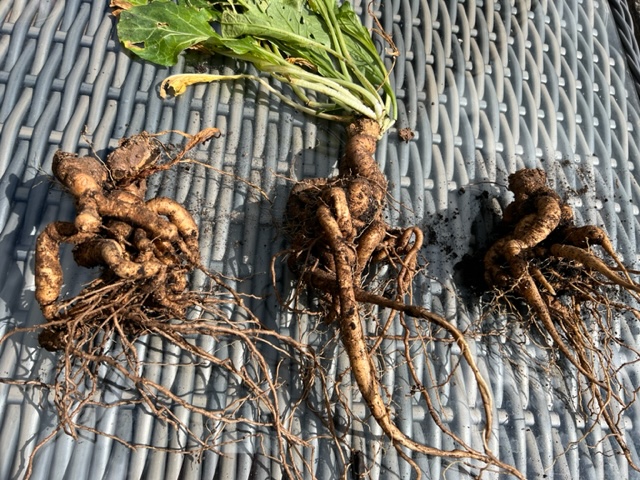Mayblog 2023 (comes a little early due to impending cable works)
The Mandrakes of Chateaux Chaos.
With Igor and Boris having thrown their leaves for the coming summer and the huge communal pot looking very overcrowded it seems a good time to repot all three of them separately. Circe has retained some of her foliage till now, strange behaviour for Mandragora officinalis, but perhaps she finally attempts to adapt to the chilly British climate. They don’t really like it here and have taken eight years to achieve a collective mass of about a kilogram from seeds sent from Thessaly in Greece.

Magic.
It seems that a whole new academic industry has sprung up studying the recent history of western esoterics. History as they say, starts yesterday, but in practise, most academics today prefer to let events settle for a decade or so before they start writing about them. This allows for events which may have appeared confusing at the time to have become even more confusing in recollection, some possible consequences to have emerged, and for the interviewing of some of the surviving guilty. I get quite a number of academics asking for interviews these days and seem to have become an historical figure in my own lifetime. Herewith an interesting offering from one of the leading lights in the field. It discusses the somewhat paradoxical aims the IOT set itself and it presents multiple perspectives on ‘The Ice War’. I once got a round of applause at one of the early big IOT meetings by proclaiming the IOT Pact as ‘A Cult for those who don’t want to join a Cult’. Just how that played out in practise remains a subject of considerable controversy and ongoing debate. The following paper provides a substantial read.
Not Magic.
This years ‘Breaking Convention’ has come and gone with predictable and dreary results - a bunch of would be scientists and shamans reinforcing a collective neurological/psychological based compromise to use their arts to merely restore acceptable normalities rather than to explore the extremities of human potential.
How much has the western esoteric tradition neutered and emasculated itself since the heady Promethean idealism of the magical revival of the late twentieth century?
Does anyone else find the current fashion for reinterpreting/downgrading esoterics into mere ‘therapy’ rather disheartening? Today the esoteric scene seems pervaded by those who merely proffer psychological therapies with new-age twists, (new-age rhymes with sewage), or they bleat on endlessly about their mental health as somehow emblematic of their spirituality.
Whatever happened to the quest for weird knowledge and strange occult powers?
(I guess few people realised just how much hard work it would take to achieve any real strange knowledge or any useful magical powers.)
Psychedelics largely failed to enlighten. Now we have a new wave of psychedelic gurus pushing their products as mere remedies for depression or trauma. The new theory runs that such substances randomly shake up many of the patterns that have become fixed in the brain and can allow for a normalising restructuring. Electroconvulsive therapy supposedly worked by exactly the same mechanism.
Physics.
Mach’s Principle remains an intriguing cosmic concept. Ernst Mach (popularly remembered for his work on the speed of sound and shock waves) first seems to have informally suggested the idea although Einstein formally attributed it to him as Mach’s Principle.
Broady stated, it asserts that the properties of the parts of the universe depend upon the properties of the whole of it. That sounds intuitively right to the holistically minded, but theorists have struggled to give it mathematical form and rigour. Einstein took some inspiration from it, but he failed to fully incorporate it into his relativistic cosmology.
Let us see how well Hypersphere Cosmology incorporates Mach’s Principle. Herewith the Wikipedia list of 11 of the more popular interpretations of the principle with annotations concerning the Hypersphere Cosmology model.
Mach0: The universe, as represented by the average motion of distant galaxies, does not appear to rotate relative to local inertial frames.
Agree. Although Godel’s theory asserts that ‘Matter everywhere rotates relative to the compass of inertia with an angular velocity of twice the square root of pi times the gravitational constant times the density’, w = 2sqrt(piGp), it can do so about randomly orientated Hopf Fibration axes within a hypersphere giving the universe an average or overall angular velocity and angular momentum of zero.
Mach1: Newton's gravitational constant G is a dynamical field.
Agree. G = Lc2/2M, where L = antipode length, M = mass of universe. The value of the gravitational constant depends on the antipode length of the universe, lightspeed, and the mass of the universe. A universe of a different size or mass would have a different value of G.
Mach2: An isolated body in otherwise empty space has no inertia.
Unfalsifiable but probably true. See Mach 7.
Mach3: Local inertial frames are affected by the cosmic motion and distribution of matter.
Agree. See Hypersphere Cosmology equations: -
6) The gravitational mass of the entire universe removes energy from photons in transit. (Redshift)
7) Individual inertial masses arise from the gravitational mass of the entire universe.
8) The gravitational mass of the entire universe slows matter in transit. (Pioneer Anomaly)
10) The gravitational mass of the entire universe reduces linear accelerations and increases orbital velocities.
11 – 15) The mass and size of the entire universe controls the proton-electron mass.
Mach4: The universe is spatially closed.
Agree. It consists of a Hypersphere L = 2GM/c2 within a Black Hole r = 2GM/c2.
The conventional interpretation mistakes the Antipode length for the Hubble length.
Mach5: The total energy, angular and linear momentum of the universe are zero.
Agree. Energy = Motion. The opposed centripetal and centrifugal accelerations A = c2/L, match on the cosmic macroscale, and probably also on the quantum microscale, we could probably mathematically summate the totality of all the multidimensional spins and all the motions that give rise to all the forces and particles within the universe to zero. 0 = +1&-1.
Mach6: Inertial mass is affected by the global distribution of matter.
Agree. mi = 2GMmg/Lc2 the inertial mass of anything within the universe depends on the mass and size of the universe which also control the c2/G ratio.
Mach7: If you take away all matter, there is no more space.
Unfalsifiable but probably true. At least it explains what lies outside of the closed universe – nothing – not even space.
Mach8: 4πpGT^2 is a definite number, of order unity, where p is the mean density of matter in the universe, and T is the Hubble time. (I don’t know who put in the pi or why.)
Agree. As p = M/2pi2r3 and T-2 = pi2r3/c2, then 4pipGT-2 = 4piMGpi2r2/2pi2r3c2
= 2piGM/rc2 ~ 1.
Mach9: The theory contains no absolute elements.
Agree. The ‘fundamental’ constants G, c, M, L, and A all depend upon each other.
Mach10: Overall rigid rotations and translations of a system are unobservable.
Unfalsifiable but probably true.
It would seem that Mach’s Principle can only apply if the universe consists of a Hypersphere of constant size.
Black Holes and Hyperspheres.
How much spacetime does the universe contain? Conventional LCDM Big Bang Cosmology asserts that the observable universe has a radius of about 13.8 bnlyr, but that due to its apparent expansion since a hypothetical big bang it may now extend to perhaps 95 bnlyr and it may have the potential to expand into spacetime indefinitely.
Hypersphere Cosmology asserts that the entire universe consists of a finite but unbounded Hypersphere, closed in both space and time with an Antipode length of only13 bnlyr. This still makes it awesomely huge, but considerably smaller than the observable LCDM universe and certainly not even potentially spatially infinite. Such a Hypersphere will exist within a Black Hole with a radius equal to the Hypersphere’s Antipode length, as shown below.
 .
.
Physicists commonly assume that if matter collapses under its own gravity to form a black hole with a Schwarzschild radius of 2GM/c2 then it will continue to collapse until the matter forms a zero size singularity inside that Schwarzschild radius. The Penrose – Hawking Singularity Theorems assert this, but only on the basis that they cannot conceive of anything that would stop it.
Hypersphere Cosmology asserts that matter will cease to collapse within a black hole when all the matter has collapsed to half the Schwarzschild diameter because at this point a Hypersphere will form within the Black Hole. Such hyperspheres will have a rotational velocity of lightspeed and will resist further compression which would push their rotational velocity past lightspeed.
If the Schwarzschild radius r and the Hypersphere antipode length L both equal 2GM/c2, then L = r, or L = d/2, where d means Black Hole diameter. See A).
If we inhabit a universe that consists of the inside of a Black Hole and a Hypersphere has formed within it, then the optical horizon conventional cosmologists estimate to lie at ~13.4 bnlyr, and which Hypersphere Cosmology estimates to lie at almost exactly 13 bnlyr, represents the universe’s antipode distance not its radius.
If so, then the Hypersphere Cosmology universe has considerably less volume and a considerably higher density than conventional cosmology currently asserts. No surprise then that the Hubble Deep Field contains such an astonishing number of galaxies.
Furthermore, a Black Hole of any mass within the universe should contain a Hypersphere.
Breaking News
https://academic.oup.com/mnras/article/522/2/1736/7035603
The occurrence of greater numbers of quasars at long cosmic distances has become interpreted as evidence for the evolution of galaxies since a big bang, on the basis that younger (more distant) galaxies would have plenty of gas surrounding their central black holes, this gas would become sucked in to give rise to the quasar effect, and then when it had become exhausted the quasar activity would cease.
It now seems that quasar activity arises from the collision of galaxies driving gas towards their central black holes.
In which case, quasar distribution ceases to provide supporting evidence for the big bang hypothesis!!!